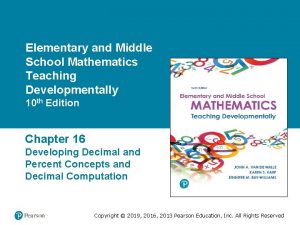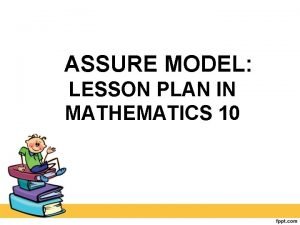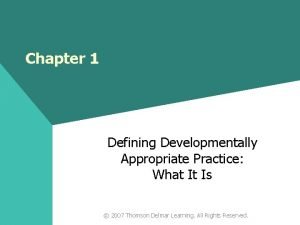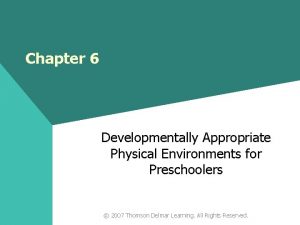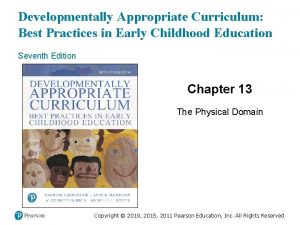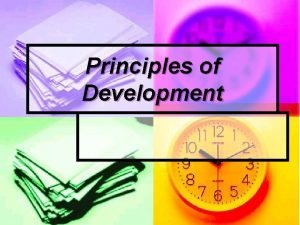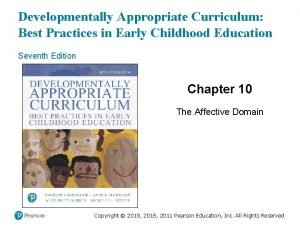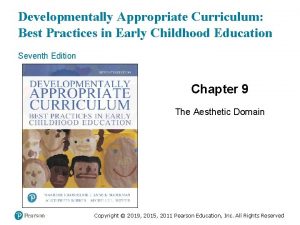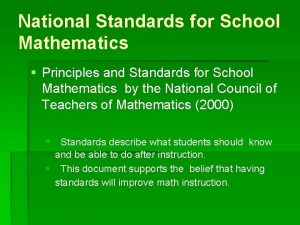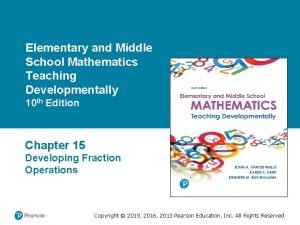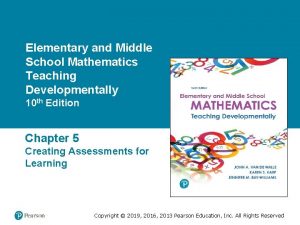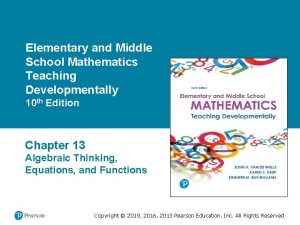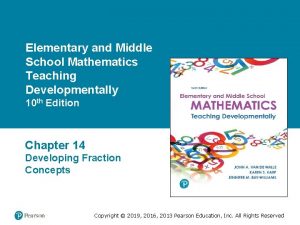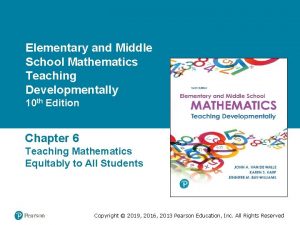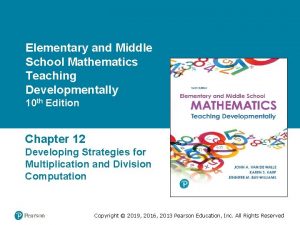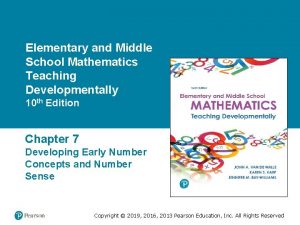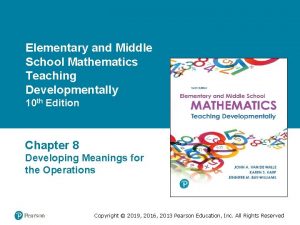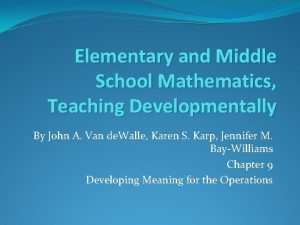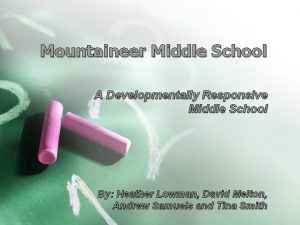Elementary and Middle School Mathematics Teaching Developmentally 10




















- Slides: 20

Elementary and Middle School Mathematics Teaching Developmentally 10 th Edition Chapter 17 Ratios, Proportions, and Proportional Reasoning Copyright © 2019, 2016, 2013 Pearson Education, Inc. All Rights Reserved

Learner Outcomes 17. 1 Describe the essential features of a ratio, including how it relates to fractions, and articulate ways to help students understand be able to use ratios. 17. 2 Contrast proportional and nonproportional situations using additive and multiplicative examples. 17. 3 Illustrate the different ways to solve proportional problems and describe a developmental progression for these ways. 17. 4 Compare traditional methods of teaching proportional reasoning to research-based methods. Copyright © 2019, 2016, 2013 Pearson Education, Inc. All Rights Reserved

Standards-Based Development Grade 4: Solve multiplication problems involving a multiplicative comparison. Grade 5: Identify relationships between two varying quantities. Grade 6: A critical area focuses on connecting ratio and rate to multiplication and division; students solve problems involving ratios and rates. Grade 7: A critical area focuses on proportionality, solving multistep problems; students write proportions as equations and graph them, as well solve problems involving interest, tax, gratuities and so on. Copyright © 2019, 2016, 2013 Pearson Education, Inc. All Rights Reserved

Types of Ratios Part-to-part ratios Ratios as quotients Represents one part in relation to another part of a whole Thought of as quotients 9 females and 7 males in a group, 9/7 meaning a ratio of nine to seven (This is not a fraction. ) Buy 4 kiwis for $1. 00. Ratio of Part-to-whole ratios Comparison of a part to a whole 9 girls to 16 students in the group, 9/16 meaning nine-sixteenths of the class (a fraction) money $1. 00 to 4 kiwis or Ratios as rates Miles per gallon, miles per hour, $ per square yard, passengers per busload, and roses per bouquet are all rates Relationships between two units of measure, inches per foot, milliliters per liter are also rates. Copyright © 2019, 2016, 2013 Pearson Education, Inc. All Rights Reserved

Two Ways to Think About Ratio Forming a ratio is a cognitive task not a writing task Multiplicative Comparison Composed Unit Wand A is 10 inches long and Wand B is 15 inches long. Thinking of the ratio as one unit There are two ways to show the relationship- The ratio is 10 to 15 or 15 to 10. The short wand is two-thirds as long as the long wand; the long wand is three-halves as long as the short want. 4 kiwi for $1. 00 then 8 for $2. 00, 16 for $4. 00 This is iterating. Partitioning examples: 2 for How many times greater is one thing than another? What fractional part is one thing of another? Copyright © 2019, 2016, 2013 Pearson Education, Inc. All Rights Reserved

Proportional Reasoning (1 of 2) Proportional thinkers: Understand ratios as distinct entities representing relationship different from the quantities they compare. Recognize proportional relationships as distinct from nonproportional relationships in real-world contexts. Have a sense of covariation. Develop a wide variety of strategies for solving proportions or comparing ratios, most of which are based on informal strategies rather than prescribed algorithms Copyright © 2019, 2016, 2013 Pearson Education, Inc. All Rights Reserved

Proportional Reasoning (2 of 2) Early ideas of proportional reasoning; • One-to-one correspondence, place value, fraction concepts and multiplicative reasoning • Compare situations, and discuss whether it is an additive, multiplicative or constant relationship. • A ratio is a number that expresses a multiplicative relationship (part-part or part-whole) that can be applied to a second situation. Copyright © 2019, 2016, 2013 Pearson Education, Inc. All Rights Reserved

Examine These Situations and Identify the Proportional Reasoning You Would Use Janet and Jeanette were walking to school, each walking at the same rate. Jeanette started first. When Jeanette has walked 6 blocks, Janet has walked 2 blocks. How far will Janet be when Jeanette is 12 blocks? Lisa and Linda are planting corn on the same farm. Linda plants 4 rows and Lisa plants 6 rows. If Linda’s corn is ready to pick in 8 weeks, how many weeks will it take for Lisa’s corn to be ready? Kendra and Kevin are baking cookies using the same recipe. Kendra makes 6 dozen and Kevin makes 3 dozen. If Kevin is using 6 ounces of chocolate chips, how many ounces will Kendra need? Copyright © 2019, 2016, 2013 Pearson Education, Inc. All Rights Reserved

Additive and Multiplicative Comparisons How are these two tasks alike and how are they different? 1. A red car and a silver car are traveling at the same constant rate. When the red car has traveled 20 miles, the silver car has traveled 12 miles. How far will the red car be when the silver car has traveled 32 miles? 2. A red and silver car are traveling at different but constant rates. They pass Exit 95 at the same time. When the red car has traveled 20 miles past Exit 95, the silver car has traveled 16 miles. How far will the red car be when the silver car has traveled 32 miles? Decide which has more, and share your reasoning. Copyright © 2019, 2016, 2013 Pearson Education, Inc. All Rights Reserved

Covariation Two different quantities (a ratio) vary together. The ratio of two measures in the same setting is a within ratio. Example – A ratio of oranges to money may involve 4 oranges for $1. 00: 4/$1 = 16/$4 Both of these are within ratios. Ratio of two corresponding measures in different situations is a between ratio. Example – Comparing the ratio of the original number of oranges (4 to $1. 00) to the number of oranges (16 to $4. 00) in a second situation: 4/16 = $1/$4 Both of these are between ratios. Copyright © 2019, 2016, 2013 Pearson Education, Inc. All Rights Reserved

Covariation in Geometry and Measurement Copyright © 2019, 2016, 2013 Pearson Education, Inc. All Rights Reserved

Covariation in Algebra Proportional situations are always linear situations. Graphs provide a way of thinking about proportions and connect proportional thoughts to algebra. Copyright © 2019, 2016, 2013 Pearson Education, Inc. All Rights Reserved

Activity 17. 9 Dripping Faucet Materials – Pose this problem: If you brush your teeth twice a day and leave the water running when you brush. How many gallons of water will you waste in one day? In a week? A month? Any number of days? Students need to gather data and record it in a ratio table. Students found ratio was Formula y = 1/8 x Copyright © 2019, 2016, 2013 Pearson Education, Inc. All Rights Reserved

Activity 17. 10 Comparing Lemonade Recipes Unit Rate or Scale Factor? Recipes are 3 cups water 4 cups of water 2 cups concentrate 3 cups of concentrate Which pitcher will have the stronger lemon flavor, or will they both taste the same? Copyright © 2019, 2016, 2013 Pearson Education, Inc. All Rights Reserved

Activity 17. 12 Which Camp Gets More Pizza? Unit Rate or Scale Factor Two Camps of Scouts are having pizza parties. The leader of the Bear Camp ordered enough so that every 3 campers will have 2 pizzas. The leader of the Raccoon Camp ordered enough for every 5 campers. Did the Bear Campers have more pizza? Copyright © 2019, 2016, 2013 Pearson Education, Inc. All Rights Reserved

Solving Problems Using Ratio Tables Something weighing 160 pounds on Earth is 416 pounds on Jupiter. If something weighs 120 pounds on Earth, how many pounds would it weigh on Jupiter? Review the three solutions. Copyright © 2019, 2016, 2013 Pearson Education, Inc. All Rights Reserved

Solving Proportion Problems with Tape or Strip Diagram The ratio of boys to girls in this class is 3 to 4. If there are 12 girls, how many boys are there? If there are 21 children, how many boys are there? There are 5 more girls than boys. How many girls are there? Copyright © 2019, 2016, 2013 Pearson Education, Inc. All Rights Reserved

Equations (Cross Products) Central to teaching students to reason proportionally is to teach ideas and restrain the quick path to computation. Visual of correct proportional equation to determine unit rate or price or scale factor Line segments can also model a unit rate scale factor. Copyright © 2019, 2016, 2013 Pearson Education, Inc. All Rights Reserved

Teaching Proportional Reasoning 1. Used composed unit and multiplicative comparison ideas in building understanding of ratio. 2. Help students distinguish constant, additive, and multiplicative comparisons by providing examples of each and discussing differences. 3. Provide ratio and proportion tasks in a wide range of contexts, including situations involving measurement, prices, geometric and other visual contexts, and rates of all sorts. 4. Engage students in a variety of strategies for solving proportions, sequencing instruction from most intuitive to more abstract. 5. Recognize that the cross product algorithm, while important to understand use, is not the goal of teaching proportions- the goal is that students are able to recognize proportional situations and to solve them efficiently. Copyright © 2019, 2016, 2013 Pearson Education, Inc. All Rights Reserved

Common Challenges and Misconceptions Related to Ratios and Proportions Challenge or Misconception What It Looks Like How to Help 1. Use additive reasoning when the situation requires multiplicative reasoning. Student thinks that because a giant’s pencil is 15 inches longer than a typical pencil, the giant is 15 inches taller than a typical person (see Activity 17. 4). See the discussion and tasks in Types of Comparing Situations section. 2. Use phrases that imply confusion between additive and multiplicative reasoning (Rathouz, Cengiz, Krebs, & Rubenstein, 2014). Student says “is four times more than” rather than “is four times as long as” for a multiplicative comparison. Compare the two statements and their meanings. 3. Experience difficulty determining how to graph ratios (Kastberg, D’Ambrosio, Lynch. Davis, Mintos, & Krawczyk, 2014). Students cannot decide which axes to use for the two measures; students have difficulty interpreting a completed graph. Discuss that with ratios, the choice of which variable is on the x-axis and which variable goes on the y-axis is arbitrary. Use Activities 17. 3 and 17. 4. Use precise language. Use revoicing to help students use the correct language. Compare graphs that are done both ways. Point at values and ask what they mean related to the context. Copyright © 2019, 2016, 2013 Pearson Education, Inc. All Rights Reserved
 Elementary and middle school mathematics 10th edition
Elementary and middle school mathematics 10th edition Detroit public schools
Detroit public schools Assure lesson plan
Assure lesson plan Kindergarten japan uniform
Kindergarten japan uniform Instructional aims
Instructional aims Inductive method
Inductive method Microteaching cycle
Microteaching cycle 10 effective dap teaching strategies
10 effective dap teaching strategies What does developmentally appropriate mean
What does developmentally appropriate mean Developmentally appropriate environment
Developmentally appropriate environment Developmentally appropriate curriculum 7th edition
Developmentally appropriate curriculum 7th edition Define developmentally appropriate practice
Define developmentally appropriate practice Principles of developmentally appropriate practice
Principles of developmentally appropriate practice Developmentally appropriate curriculum 7th edition
Developmentally appropriate curriculum 7th edition Developmentally appropriate curriculum 7th edition
Developmentally appropriate curriculum 7th edition Principles and standards for school mathematics
Principles and standards for school mathematics Holland middle school track
Holland middle school track Ubujan elementary school
Ubujan elementary school Schoolmax gradebook
Schoolmax gradebook Mckay elementary school
Mckay elementary school Sealey elementary
Sealey elementary
